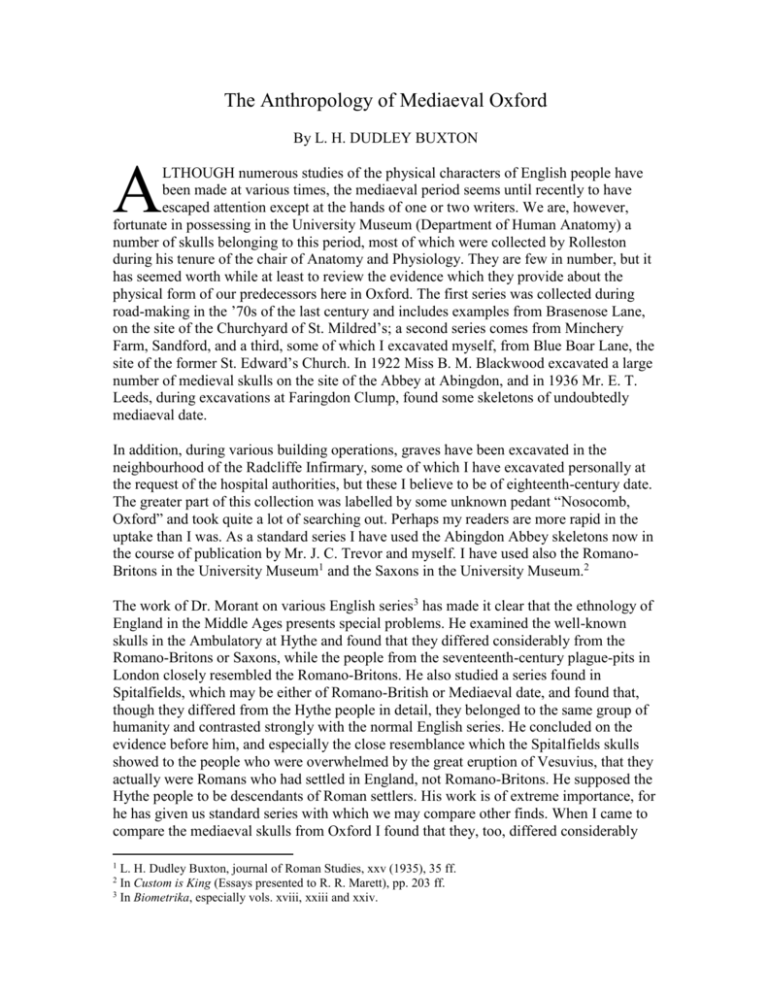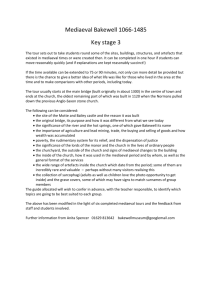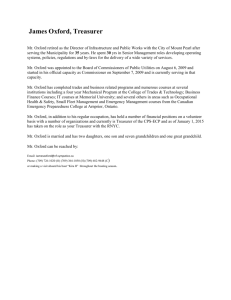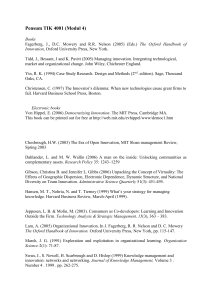The Anthropology of Mediaeval Oxford
advertisement

The Anthropology of Mediaeval Oxford By L. H. DUDLEY BUXTON A LTHOUGH numerous studies of the physical characters of English people have been made at various times, the mediaeval period seems until recently to have escaped attention except at the hands of one or two writers. We are, however, fortunate in possessing in the University Museum (Department of Human Anatomy) a number of skulls belonging to this period, most of which were collected by Rolleston during his tenure of the chair of Anatomy and Physiology. They are few in number, but it has seemed worth while at least to review the evidence which they provide about the physical form of our predecessors here in Oxford. The first series was collected during road-making in the ’70s of the last century and includes examples from Brasenose Lane, on the site of the Churchyard of St. Mildred’s; a second series comes from Minchery Farm, Sandford, and a third, some of which I excavated myself, from Blue Boar Lane, the site of the former St. Edward’s Church. In 1922 Miss B. M. Blackwood excavated a large number of medieval skulls on the site of the Abbey at Abingdon, and in 1936 Mr. E. T. Leeds, during excavations at Faringdon Clump, found some skeletons of undoubtedly mediaeval date. In addition, during various building operations, graves have been excavated in the neighbourhood of the Radcliffe Infirmary, some of which I have excavated personally at the request of the hospital authorities, but these I believe to be of eighteenth-century date. The greater part of this collection was labelled by some unknown pedant “Nosocomb, Oxford” and took quite a lot of searching out. Perhaps my readers are more rapid in the uptake than I was. As a standard series I have used the Abingdon Abbey skeletons now in the course of publication by Mr. J. C. Trevor and myself. I have used also the RomanoBritons in the University Museum1 and the Saxons in the University Museum.2 The work of Dr. Morant on various English series3 has made it clear that the ethnology of England in the Middle Ages presents special problems. He examined the well-known skulls in the Ambulatory at Hythe and found that they differed considerably from the Romano-Britons or Saxons, while the people from the seventeenth-century plague-pits in London closely resembled the Romano-Britons. He also studied a series found in Spitalfields, which may be either of Romano-British or Mediaeval date, and found that, though they differed from the Hythe people in detail, they belonged to the same group of humanity and contrasted strongly with the normal English series. He concluded on the evidence before him, and especially the close resemblance which the Spitalfields skulls showed to the people who were overwhelmed by the great eruption of Vesuvius, that they actually were Romans who had settled in England, not Romano-Britons. He supposed the Hythe people to be descendants of Roman settlers. His work is of extreme importance, for he has given us standard series with which we may compare other finds. When I came to compare the mediaeval skulls from Oxford I found that they, too, differed considerably 1 L. H. Dudley Buxton, journal of Roman Studies, xxv (1935), 35 ff. In Custom is King (Essays presented to R. R. Marett), pp. 203 ff. 3 In Biometrika, especially vols. xviii, xxiii and xxiv. 2 L. H. DUDLEY BUXTON from the “standard English” for this district,—by “standard English” in this paper I mean the Romano-British, Anglo-Saxon, modern-English,—with two exceptions, the Beaumont Street series and the Faringdon Clump series. Although the differences extend over a number of the measurements, including both those of the face and those of brain case, I propose to limit myself to the latter, partly because they present the most striking differences and partly because owing to the fragile nature of the bones the faces are more apt to be destroyed. The measurements which I have used are (1) the length of the brain case from the glabella to the occiput, which gives the length from the middle of the ridges above the nose to the most prominent point on the back of the skull; (2) the maximum breadth measured on the parietal bones; (3) the height from the basion to the bregma. I have used three “indices” (a) the cephalic, i.e., the percentage ratio of (2) to (1); (b) the vertical, i.e. the percentage ratio of (3) to (1); (c) the transverse vertical, the percentage ratio of (3) to (2). Where later in this paper I have used the expression “significantly different” I mean it to be inferred that calculated by the theory of probability it is more than twenty to one against the two series belonging to the same group. It will readily be inferred that where two series are significantly different in several characters the odds would be overwhelmingly against their belonging to the same group provided that the characters selected were truly independent. As, however, parts of the same skull can hardly be considered independent, the odds are not always so overwhelming. We take 20 to I odds, the five per cent chance to make quite sure. I am aware that to base any conclusions on less than, say, forty skulls of the same sex is considered by many to be an uncertain undertaking. When, however, we have differences as great as are found in these skulls a smaller number gives approximate results. Further, unless a large unknown ossuary turns up, we are likely only to get small additions to our collection from time to time. The skulls discussed in this paper have taken 77 years to get together, so it seems unnecessary or at least unjustified caution to wait till we have a sufficient number to be triple bound with statistical brass. My available material is as follows: four males and two females from St. Mildred’s Churchyard, two males from Blue Boar Lane, found during work on St. Columba’s Church Hall, seven males and six females from Minchery Farm, Sandford, six males from Beaumont Street, six males and one female from Faringdon Clump, six males and two females from a burial ground near the Radcliffe Infirmary, and, for comparison, thirty-five male skulls and nine females from Abingdon. I am indebted to Dr. H. E. Salter for the following information about the dates of this material. St. Mildred’s church was in use till about 1420. The graveyard of St. Edward’s, where St. Columba’s now stands, was not used after about 1390. Minchery Farm was probably the burial-place for Littlemore Priory (c. 1120–1523) but as there seems to have been no parochial chapel for the villagers of Littlemore in the middle ages, Dr. Salter presumes they were buried at Minchery. The bones from Abingdon Abbey are probably about the same date and, as they include some women, are probably in part at least some of the townsfolk. Dr. Salter can tell me nothing about Beaumont Street. He tells me that the White Friars had a burial-ground in the neighbourhood, but I have not included them in my averages owing to this uncertainty. I believe the Infirmary bones to be of eighteenth-century date, but can only date them provisionally. The excavations at 2 ANTHROPOLOGY OF MEDIAEVAL OXFORD Faringdon Clump are fully described by Mr. E. T. Leeds,4 and must be twelfth century. I cannot however agree with Leeds that the bones are those of defenders who were smothered in the ditch. The bodies may well have included people killed during some assault, however, but they include presumably a noncombatant, as one skull is certainly that of a woman. Leeds states that he found no trace of fire during his excavation. As, however, the bones were very inadequately cremated, I can only suggest that possibly they were thrown into the ditch and that brushwood or other inflammable material was burnt over them (the fronts of their faces show traces of burning) an obvious expedient if continued hostilities made burial impossible. Apart from Leeds’ finds, only the St. Edwards material can be dated archaeologically, and the pottery agrees with Dr. Salter’s opinion given above. There are also one or two other scattered finds, a skull from Logic Lane about which Dr. Salter writes ‘If a body was buried in Logic Lane it must have been in the year when Oxford was under an interdict (1355), or it was the burial of a suicide.’ I have one female skull which I believe, though I am not quite sure, came from one of the graveyards of St. John’s Hospital (c. 1180–1450) in Magdalen. A skull was found during some repairs in the G.W. Railway yard at Oxford. It was buried in lime, but I have no clue as to the date. On the basis of the information given above I have felt justified in grouping my material as follows: first, Oxford Mediaeval, which includes the skulls from the graveyards of St. Mildred’s, St. Edward’s and Minchery; Beaumont Street, which I have kept separate because of the uncertainty of dating; Faringdon Clump; eighteenth-century Oxford (that is, the bones from the Infirmary) and Abingdon mediaeval. It became perfectly clear that I had to do with a mixture of two very different types of skulls, but that with so small series any form of division is necessarily rather hazardous. Before, however, I give averages it may be worth while to analyse the figures in detail. Head length and cephalic index appeared to be possible methods of approach and on this basis I obtained the following table: Graveyard < 184 St. Mildred’s Minchery St. Edward’s Beaumont Street Faringdon Clump Eighteenth-century Oxford Abingdon 4 3 5 1 20 Head Length 184– > 194 194 1 2 2 3 1 4 2 3 2 13 Antiquaries Journal, xvi (1936), 165; xvii (1937), 294. 3 2 < 75 2 4 5 3.5 Cephalic Index 75–80 > 80 3 2 3 1 13.5 4 4 16 L. H. DUDLEY BUXTON An analysis of these figures suggested that while certainly St. Mildred’s and Minchery belonged to the same group as Abingdon, St. Edward’s appeared to be a different group, Beaumont Street might be transitional, and Faringdon Clump, and eighteenth-century Oxford belonged to a very different group. It seemed, however, advisable on the basis of my archaeological evidence to group St. Edward’s with the other mediaeval Oxford material and to see the effect of averages. In the table which follows I have worked out the average cephalic index, the vertical index, and the length, breadth and height. The figures in brackets indicate the number on which the averages are based. MALES Group Oxford Mediaeval Abingdon Medieval Miscellaneous Mediaeval Beaumont Street Faringdon Clump Eighteenth-century Oxford Frilford (R.B.) Abingdon, Saxon Oxford District Saxon Cephalic Index 79.0 (13) 79.3 (33) Vertical Index 73.0 (8) 73.3 (28) 81.5 (15) Length Breadth Height 181.6 (13) 183.8 (35) 145.9 (13) 146.0 (37) 134.3 (8) 134.7 (30) 73.8 (12) 181.9 (16) 148.5 (15) 132.9 (12) 75.1 (5) 72.2 (5) 72.8 (5) 72.4 (4) 68.7 (3) 70.5 (5) 188.2 (5) 192.0 (5) 193.6 (5) 143.0 (6) 139.2 (6) 141.2 (5) 135.0 (4) 133.3 (4) 136.4 (5) 75.4 (45) 74.7 (26) 74.9 (18) 69.1 (25) 72.3 (25) 70.2 (18) 191.1 (52) 193.1 (29) 188.9 (19) 144.2 (50) 144.2 (26) 140.5 (18) 132.6 (26) 137.9 (26) 132.6 (20) FEMALES Group Oxford Mediaeval Abingdon Medieval Faringdon Clump Eighteenth-century Oxford Frilford (R.B.) Cephalic Index 81.8 (6) 78.8 (6) Vertical Index 73.0 (5) 73.9 (5) 78.3 (1) 78.8 (2) 76.0 (31) Length Breadth Height 173.7 (7) 176.7 (7) 140.6 (8) 138.7 (9) 125.25 (6) 129.1 (7) 69.1 (1) 73.5 (2) 174.8 (1) 176.5 (2) 137.0 (1) 138.0 (2) 120.6 (1) 129.0 (2) 70.0 (19) 180.1 (35) 136.5 (34) 125.7 (19) In the comparative material I have purposely included as far as possible material from close at hand. It will become clear at once that the Oxford and the Abingdon mediaeval skulls stand in a group by themselves. The Beaumont Street skulls, whatever their date, are uncommonly close to the average we should obtain if we pooled the Saxon and Romano-British material; Faringdon Clump and eighteenth-century Oxford are very close to one another, though there is a difference in height; with so small numbers it is in fact rather remarkable to get such close agreement at all. Now, if we analyse our material a 4 ANTHROPOLOGY OF MEDIAEVAL OXFORD little further, I think we are justified in assuming that the Oxford and Abingdon mediaeval series are the bones of people who for the most part lived in one or other of those towns. The Frilford and Abingdon Saxons and the former Romano-Britons represent little rural communities. Probably the Faringdon people are either local mercenaries, or, as Leeds has suggested, quite possibly West country men-at-arms, or a mixture, certainly not local townsfolk. The eighteenth-century group are most likely either to be country people who died in hospital or local paupers: but I do not think the latter. They are rather the bones of the poor than the bones of those poor unfortunates who find a pauper’s grave, I hazard a guess from the examination of their bones that most of them died of disease in middle life and I suggest that the chances are in favour of their being hospital patients whose relations were not well enough off to take their bodies home and who had no parish in the city. My argument therefore is that we have two groups of mediaeval city-dwellers, possibly three, for Beaumont Street is uncertain, and two sets of Oxfordshire country folk, or at least not Oxford people, one twelfth century and one eighteenth, and, for comparison, the people of the land in earlier times. The figures show clearly that in mediaeval times there were living in Abingdon and Oxford groups of people differing from both Saxons and Romano-Britons and from later people, and, though I have few figures, certainly different from the modern people of England. Who were they? They might have been strangers, though it is unlikely that with all the dead to find we have found just two groups of strangers, one of 33 and one of 13 skulls, who exactly resembled each other and differed from any one else. Could they have been Normans? Or more likely perhaps a mixture of Normans and Saxons? There is a little evidence on this point. During reconstruction of buildings in the middle of the nineteenth century measurements were made of skulls taken from the tombs of the following5 and we may presume they were actually the bones of the persons supposed to be buried in those tombs: Edmund Langley, Duke of York; Ralph Flambard; Geoffrey Rufus, Bishop of Durham (1133–1149); and Richard de Kellawe who held the same see from 1311 to 1316. Rolleston’s very careful examination of the bones of Edmund Langley6 makes it almost certain that the bones are really his. In addition to his bones the bones of two women were found in his tomb. Rolleston here again argues with some plausibility that they are the bones of Anne Mortimer and Isabella of Castile, but as one might be Mediterranean, and we do not know which is which, little can be judged from their cephalic indices. It should, however, be noted that the two ladies have rather differently shaped skulls from the four men. These four are all remarkable for their extreme brachycephaly and though argument from four skulls alone is unsafe, when they are definitely consistent, it does suggest the reasonable plausibility that the Normans tended to be round-headed. It would appear that Richard Coeur de Lion’s skull was also measured but I can only find a statement about the size of his brain. There is, however, a little further evidence. Professor G. N. Clark suggested that possibly mediaeval brasses might serve as a clue, more especially as they were probably not actual portraits bur rather generalizations and therefore likely to represent what the journeyman 5 6 Rolleston ap. J. T. Fowler, Archaeologia, xlv, 389 ff. Rolleston and Evans, Archaeologia, xlvi. 5 L. H. DUDLEY BUXTON artist thought the people looked like. An examination of some brasses in Chipping Norton Church in company with Professor Clark showed very interesting results. The majority of the brasses of the burgesses of that town convinced me that we had here representations of a population almost exactly like that with which I was familiar from the Oxford mediaeval skulls, their contemporaries. Most of them represented a round-headed, round-faced person, but, especially in some of the ladies (though this may be accident), a rather narrower type could also be discerned. Though statistically such evidence, which is purely subjective, may be worthless, it is at least suggestive that the generalized portraiture of the Cotswold wool-merchants seems to represent a type similar to the skulls of persons who, whether foreigners or not, were buried in the Oxford city graveyards. Before trying to trace the parallels on the continent to these round-headed people, it may be worthwhile to summarize the implications. First, it is probable that we have in Oxford an absolutely continuous tradition extending from at least the twelfth century onwards, though it may be suggested that there is some sort of break between the true middle ages and the modern world. Secondly there can be no doubt at all that an examination of skulls suggests, but does not absolutely make certain, that whereas the modern inhabitants of the region belong to the same type as the Saxons and Romano-Britons there was a different type represented in Oxford in mediaeval times. On the other hand the bones from Faringdon Clump suggest that the old type was, as must be expected, still in existence. If this were the only evidence, we should say that we had got foreigners in Oxford. But we have people of the same racial type at the same time in Abingdon, and, to go further afield, at Rothwell in Northamptonshire, at Hythe in Kent, in Hastings Castle, at Butley Priory, and possibly elsewhere. Provisionally I am inclined to suggest that the monastic communities and townsfolk were mainly of Norman type, whereas the old type may have persisted in the country, for which at present we have just no evidence. The origin of these people can be best understood by a consideration of the diagram (FIG. 23). Such consideration shows, on the basis of the cephalic index and the head length, that three distinct groups can be found among the selected series, possibly even four. The first group includes, grouped very closely together, three series from English plague pits in London (Moorfields, Farringdon Street and Whitechapel), the Reihengraber, Merovingian Franks, Lowland Scots and the Beaumont Street skulls. Close to these are three other English groups, a Romano-British series from Frilford and York, and a series of British soldiers who died at the end of the eighteenth and beginning of the nineteenth century and came from all over the British Isles, and also a Saxon series. More scattered but probably from the same series are the Abingdon Saxons, Faringdon Clump and the eighteenth-century Oxford, while the Neolithic English are remarkable for their large heads and low cephalic indices. This series may probably with some justification be called “Nordic,” though one hesitates to use this term to-day. It will be noticed that it includes English skulls of all dates from Neolithic times onwards except for the Bronze Age. Unfortunately I can only find three foreign groups which clearly come into this series, the Swedish, a combined series pooled by Morant from Retzius and Furst and including Neolithic, Bronze and Early Iron Age, the Reihengraber skulls and the Franks. A series of Lowland Scots of fifteenth-century date published by Turner have not been included on 6 ANTHROPOLOGY OF MEDIAEVAL OXFORD the diagram as their measurements practically coincide with those of the Farringdon Street series. Figure 23 The second group includes a wide variety of people, from all over Europe. It is important to note that both the Oxford and Abingdon mediaeval belong to this group. The British series in this group include the English Bronze Age,7 the Scottish short-cist people, a Scottish mediaeval series published by Turner, a series from Rothwell in Northamptonshire measured by Trevor and series from Spitalfields and Dunstable. There seems little reason to doubt that though there may be one or two later skulls amongst the Rothwell material the greater part of it is definitely mediaeval. The Spitalfields series cannot be dated. The Dunstable series, though considered by the writers of the paper in 7 Figures from Morant, Biometrika, 1926, Morant obtained his means by taking all the published Bronze Age material and removing by a method of mathematical calculation, the skulls of this period which belonged to the Neolithic type. This seems an arbitrary proceeding but is almost certainly the only way in which an average of these invaders’ measurements can be obtained. 7 L. H. DUDLEY BUXTON Biometrika8 to be of the fifth to sixth century, cannot be certainly dated on archaeological grounds. There are in the collection in Oxford other certainly mediaeval skulls from England but they are too few to be included in this table. It should be noted that most of the mediaeval series which are archaeologically sound are monastic or academic in origin, and therefore may be alien. Rothwell does appear to be definitely a collection of mediaeval English. It is further worthy of remark that in the same crypt at Rothwell there is another series of skulls which differs from the series quoted in their form and belong to the ‘normal’ English series. They can in the majority of cases be selected out by the difference in their colour, but there are a few doubtful cases. They seem to have been buried in the churchyard, unlike the others which were, from the condition of the bones, apparently exposed, possibly in a charnel house. It should be mentioned here that we apparently have in Rothwell as in Oxford a change from one population to another. The foreign parallels cover the whole of central and southern Europe, and a wide period of time. In the south, skulls from Etruscan and Roman tombs at Tarquinii, and those from the excavations at Pompeii go back to classical times. The two series from Paris are one mediaeval and one modern. I have included two modern series from central Europe, one from Baden and the other from a Jewish cemetery at Prague. The most surprising series is that of the Finns, who, in spite of their Asiatic language, are certainly not ‘Mongoloid,’ but akin to our predecessors in Oxford. The Hythe series belong to yet another group paralleled in Europe from Italy and Czechoslovakia but they are outside my present terms of reference. It seems to be clear that we have had in Britain two series of round-headed invaders. The first came in the Bronze Age. They lived side by side with the older ‘neolithic type,’ who in the Oxford district were more numerous and no traces of them can certainly be found in the Romano-British or Saxon periods. The second invasion of this type took place in mediaeval times. At this period on the whole the grouping is more compact; by this I mean that whereas in Bronze Age times we find the invaders and the aborigines mixed up, in mediaeval graveyards we find with some exceptions either one or the other, and, as far as we know at present, mostly the invaders. On the other hand attention must be drawn to the fact that so far all our mediwval bones, except the very small group from Faringdon Clump come from urban areas. The relationships from continental sources do not really help us to solve the problem of these invaders. Italy, Germany, Austria, Finland, and France are all possible homelands for our mediaeval round-heads. I am rather inclined to look on the question as a general expansion of a particular racial type, similar to the former expansion in Bronze Age times, and one not necessarily or entirely associated with any particular type of culture. On the other hand there are two points which seem to me to be of importance. First, there can be little doubt that in the opinion of many the sixteenth century in England does mark a period of transition, almost a period of changing racial psychology in the English people. Secondly there certainly was no invasion about this time which could possibly account for the change of a racial stock such as for instance occurred at the end of the Bronze Age. Further here in Oxford we have an absolutely continuous tradition, although there is of course no reason why this tradition should not have been maintained in spite of a change of race. 8 Dingwall and Young, Biometrika, xxv (1933). 8 ANTHROPOLOGY OF MEDIAEVAL OXFORD I am inclined to suggest absolutely provisionally and subject to much further evidence that the return to the old English stock may have occurred in this way. The aliens did succeed in establishing their racial form in the towns, and by far the greater number of the brachycephalic skulls belong to the earlier part of the Middle Ages. We know of the immense destruction of life which resulted from the Black Death. No doubt this plague affected both town and country, but the general result of serious epidemics and plagues is to produce a much higher mortality in crowded spaces than in the more open agricultural settlements. I once had the opportunity of seeing conditions in a large city in China where living and dead, dying and convalescent, were herded together under conditions which precluded any form of sanitation or even in some cases the provision of such vital necessities of life as food and water. The memory of the influenza epidemic of 1918, even as experienced in a large general hospital, makes one realize what can happen in crowded spaces. I therefore suggest that plague may have played a not unimportant part in wiping out the round-heads whose place has been taken once more by the earlier stock who have been in the country since Early Iron Age times. Whether there is a psychological as well as a physical difference between the two stocks is beyond the province of an archaeologist but it will be interesting to have the views of historians on this point. I should further be most grateful for any further specimens so that by additional numbers I can confirm or refute the tentative suggestions of this paper. REFERENCES In compiling comparative material I have been especially indebted to the following papers :—G. M. Morant, Biometrika, xviii (1926), NEOLITHIC ENGLISH, and BRONZE AGE; id., ibid., xxiii (1931), SPITALFIELDS; id. ibid., xxiv (1932), HYTHE. The two latter papers also contain means worked out from published sources of the following: POMPEII (Nicolucci, Crania Pompeiana, Naples, 1882) ETRUSCANS (A.S.D. Leipzig, 1887); PARIS MEDAIEVAL and MODERN (Broca, mostly MSS.); FINNS (pooled from various sources); JEWS (SEVENTEENTH CENTURY) PRAGUE (J. Matieka, Anthropologie Prague, iv (1926)). Morant, Biometrika, xx (1928) gives a long series of means from various sources: I have used the REIHENGRAEBER, pooled by Morant from a number of sources, SWEDES (Neolithic, Bronze Age and Early Iron Age) pooled from Retzius and Furst, BADEN, and the two Scottish series, the short-cist series published by Morant and Reid, Biometrika, xx (1928), the others pooled by Morant from Turner’s measurements. The MEROVINGIAN FRANKS were pooled by Morant from various sources, chiefly Broca. For FARRINGDON STREET see B. G. E. Hooke, Biometrika, xviii (1926). For WHITECHAPEL see W. R. Macdonell, Biometrika, iii (1904). For MOORFIELDS see Biometrika, v (1906). For DUNSTABLE see Dingwall and Young, Biometrika, xxv (1933). ROTHWELL and ABINGDON MEDIAEVAL were measured by J. C. Trevor and remain as yet unpublished; the Abingdon skulls are in the Oxford collection. The remaining English series are in the Oxford collection and were measured by myself; see Journ. of Roman Studies, xxvi (193) and Custom is King (1936). I owe a great debt to Dr. Morant, not only for the untiring collection of data contained in his monographs mentioned above, but also for supplying me with some as yet unpublished data and for a revision of some of the means mentioned in the above papers. The figures given for English Neolithic and for Rothwell may be considered provisional. 9







